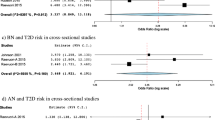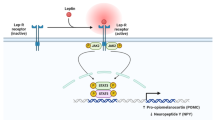Abstract
Purpose
A few recent studies have found elevated ferritin levels in patients with anorexia nervosa (AN), indicating ferritin as a potential biomarker of disease severity. The purpose of this study was to study how body mass index (BMI) and changes in BMI affect plasma ferritin concentrations in Swedish patients with eating disorders.
Materials and methods
In a retrospective computer search from 2009 to 2014, 662 patients with an eating disorder were identified from more than 200,000 individuals with electronic medical records. Three hundred and eighty-nine patients (374 females and 15 males) were found to have at least one p-ferritin value with a corresponding BMI value. Patients with AN were compared to a combined group consisting of patients with bulimia nervosa (BN) and patients with an eating disorder not otherwise specified (EDNOS).
Results
Patients with AN had lower BMI compared to the combined group of patients with other eating disorders (BMI = 16.5 ± 1.5, n = 77 vs. 21.0 ± 4.7, n = 312, p < 0.001). Patients with AN also had higher plasma ferritin levels (median 42 μg/L (range 3.3–310) vs. 31 μg/L (range 2.8–280); p < 0.001). As BMI increased in patients with AN, ferritin levels decreased (from a median of 40 μg/L (7–400) to 26 (4–170), n = 47; p < 0.001).
Discussion
Measuring ferritin in patients with AN could be valuable in monitoring improvements of nutritional status, but the full clinical value of following ferritin in individual patients has yet to be determined. The study also shows how research can benefit from electronically captured clinical data using electronic health records.



Similar content being viewed by others
References
Arcelus J, Mitchell AJ, Wales J, Nielsen S (2011) Mortality rates in patients with anorexia nervosa and other eating disorders. A meta-analysis of 36 studies. Arch Gen Psychiatry 2011(68):724–731. doi:10.1001/archgenpsychiatry.2011.74
Hoek HW (2006) Incidence, prevalence and mortality of anorexia nervosa and other eating disorders. Curr Opin Psychiatry 19:389–394
Hudson JI, Hiripi E, Pope HG Jr, Kessler RC (2007) The prevalence and correlates of eating disorders in the National Comorbidity Survey Replication. Biol Psychiatry 61:348–358
Miller KK, Grinspoon SK, Ciampa J, Hier J, Herzog D, Klibanski A (2005) Medical findings in outpatients with anorexia nervosa. Arch Intern Med 165:561–566. doi:10.1001/archinte.165.5.561
Hoek HW, van Hoeken D (2003) Review of the prevalence and incidence of eating disorders. Int J Eat Disord 34:383–396. doi:10.1002/eat.10222
Mehler PS, Brown C (2015) Anorexia nervosa—medical complications. J Eat Disord 31(3):11. doi:10.1186/s40337-015-0040-8
Rosen DS (2010) Clinical report—identification and management of eating disorders in children and adolescents. Am Acad Pediatrics 126:1240–1253. doi:10.1542/peds.2010-2821
Flierl MA, Gaudiani JL, Sabel AL, Long CS, Stahel PF, Mehler PS (2011) Complement C3 serum levels in anorexia nervosa: A potential biomarker for the severity of disease? Ann Gen Psychiatry 10:16. doi:10.1186/1744-859X-10-16
Caregaro L, Favaro A, Santonastaso P, Alberino F, Di Pascoli L, Nardi M et al (2001) Insulin-like growth factor 1 (IGF-1), a nutritional marker in patients with eating disorders. Clin Nutr 20:251–257. doi:10.1054/clnu.2001.0397
Terra X, Auget T, Agüera Z, Quesada IM, Orellana-Gavaldà JM, Aguilar C et al (2013) Adipocytokine levels in women with anorexia nervosa. Relationship with weight restoration and disease duration. Int J Eat Disord 46:855–861. doi:10.1002/eat.22166
Papillard-Marechal S, Sznajder M, Hurtado-Nedelec M, Alibay Y, Martin-Schmitt C, Dehoux M et al (2012) Iron metabolism in patients with anorexia nervosa: elevated serum hepcidin concentrations in the absence of inflammation. Am J Clin Nutr 95:548–554. doi:10.3945/ajcn.111.025817
Nova E, Lopez-Vidriero I, Varela P, Toro O, Casas J, Marcos A (2004) Indicators of nutritional status in restricting-type anorexia nervosa patients: a 1-year follow-up study. Clin Nutr 23:1353–1359. doi:10.1016/j.clnu.2004.05.004
Kennedy A, Kohn M, Lammi A, Clarke S (2004) Iron status and haematological changes in adolescent female inpatients with anorexia nervosa. J Paediatr Child Health 40:430–432. doi:10.1111/j.1440-1754.2004.00432
Nemba K, Lewis B, Watson H, Hoiles K, Zhang G, Forbes D (2014) Serum ferritin and nutritional status: insights from an eating disorders clinic population. Arch Dis Child 99:221–224. doi:10.1136/archdischild-2012-303272
Tran J, Story C, Moore D, Metz M (2013) Unexpected increased ferritin concentration in patients with anorexia. Ann Clin Biochem 50:504–506. doi:10.1177/0004563213490289
MacKenzie EL, Iwasaki K, Tsuji Y (2008) Intracellular iron transport and storage: from molecular mechanisms to health implications. Antioxid Redox Signal 10:997–1030. doi:10.1089/ars.2007.1893
Hearnshaw S, Thompson NP, McGill A (2006) The epidemiology of hyperferritinaemia. World J Gastroenterol. doi:10.3748/wjg.v12.i36.5866
Moore C, Ormseth M, Fuchs H (2013) Causes and significance of markedly elevated serum ferritin levels in an Academic Medical Center. J Clin Rheumatol 19:324–328. doi:10.1097/RHU.0b013e31829ce01f
Crook MA (2012) Hyperferritinaemia; laboratory implications. Ann Clin Biochem 49:211–213. doi:10.1258/acb.2012.012059
Narayanan V, Gaudiani JL, Mehler PS (2009) Serum albumin levels may not correlate with weight status in severe anorexia nervosa. Eat Disord 17:322–326. doi:10.1080/10640260902991202
Winston A (2012) The clinical biochemistry of anorexia nervosa. Ann Clin Biochem 49:132–143. doi:10.1258/acb.2011.011185
Guyatt GH, Oxman AD, Ali M, Willan A, McIlroy W, Patterson CJ (1992) Laboratory diagnosis of iron-deficiency anemia: an overview. Gen Intern Med 7:145–153
Acknowledgments
This work was supported by a Grant from the Medical Research Council of Southeast Sweden (FORSS).
Author information
Authors and Affiliations
Corresponding author
Ethics declarations
Conflict of interest
On behalf of all authors, the corresponding author states that there is no conflict of interest.
Ethical approval
The study was approved by the Regional Ethical Review Board of Linköping University.
Informed consent
Due to the nature of the study with more than 200 000 subjects screened, it was not possible to obtain informed consent statements.
Rights and permissions
About this article
Cite this article
Wanby, P., Berglund, J., Brudin, L. et al. Increased ferritin levels in patients with anorexia nervosa: impact of weight gain. Eat Weight Disord 21, 411–417 (2016). https://doi.org/10.1007/s40519-015-0246-4
Received:
Accepted:
Published:
Issue Date:
DOI: https://doi.org/10.1007/s40519-015-0246-4




